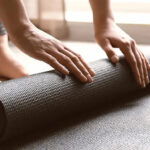A brief look at the history of the yoga mat

Today’s yoga mat is the result of centuries of yoga practice and the evolution in materials over the last decades.
At befree, we have our own mats, and, to introduce them to you, we look at the origins of this crucial yoga accessory. Read on to find out.
From grass, skins, and fabrics to the contemporary yoga mat.
The practice of yoga has millennia of history. In the beginning, the fundamental part of the discipline was meditation and pranayama.
For this reason, the yogis hardly needed support on which to feel comfortable and be able to remain still for long periods.
What did they use? According to the sacred texts, such as the Bhagavad Gita and the Upanishads, a piece of deer or tiger skin on the kusha grass, the same one used by Buddha to create his first zafu, was sufficient. Another simpler option was to spread a small piece of cloth on the ground.
The choice of these animals, which were not hunted for their skins but those that had already died, had a spiritual significance.
Deer have a connection with Buddhism because they are stubborn, like our mind when meditating, but also because of their gentleness and softness. Tigers, on the other hand, are mighty and have tremendous willpower.
The arrival of yoga in the West meant a change in the practice. The most demanding asanas were taken and popularized, in line with a more sporty and less spiritual vision of the discipline. In addition, many postures and movements were done standing.
Thus, surfaces that provided more significant support and grip began to be necessary for the mid-twentieth century. The fabrics gave way to small mats, which opened the way to the yoga mats we know today. The most commonly used materials were cotton and early synthetic fabrics.
In the mid-1960s, an amazing Western yogini forever changed the development of yoga mats: Angela Farmer. As she explains, in 1966, she was teaching Iyengar Yoga (she was a disciple of B.K.S. Iyengar) and the practice, without mats, was as complicated as it was dangerous for her body.

Aware that she needed safe support on the floor, the following year, as a yoga teacher in Munich, she realized that she could adapt the foam under the mats to prevent slipping as a mat on which to perform the asanas. The success was such that all her students imitated her!
The story goes that Angela’s father contacted the German manufacturer of the foam surfaces to start manufacturing the first mats for this specific purpose.
By the 1980s, the custom of using mats that gripped the floor and enabled yoga postures had taken hold. However, a new search for more durable materials began, as the durability of mats had been very short.
In the 1990s and 2000s, PVC and other earth-harming materials established themselves as the most common materials for mats. However, not only were they environmentally unsustainable, but they became slippery surfaces with sweat and moisture.
The last decade has been one of environmental awareness and ecology, and yoga accessories have not been left behind! Increasingly, we have sought to combine the best grip, stability, and comfort.
Of course, these are mats of the highest quality for yoga, even in the most intense types: they provide a firm grip on both sides. They are not affected by humidity and sweat.
The befree yoga mats are resistant and guarantee excellent durability. For maintenance, we recommend regular cleaning with a cloth dampened with water and storage, carefully rolled up, in a dry place.
Feel free to comment. We at Befree369 are happy to read your opinions.







2 thoughts on “A brief look at the history of the yoga mat”
Great post
Thx